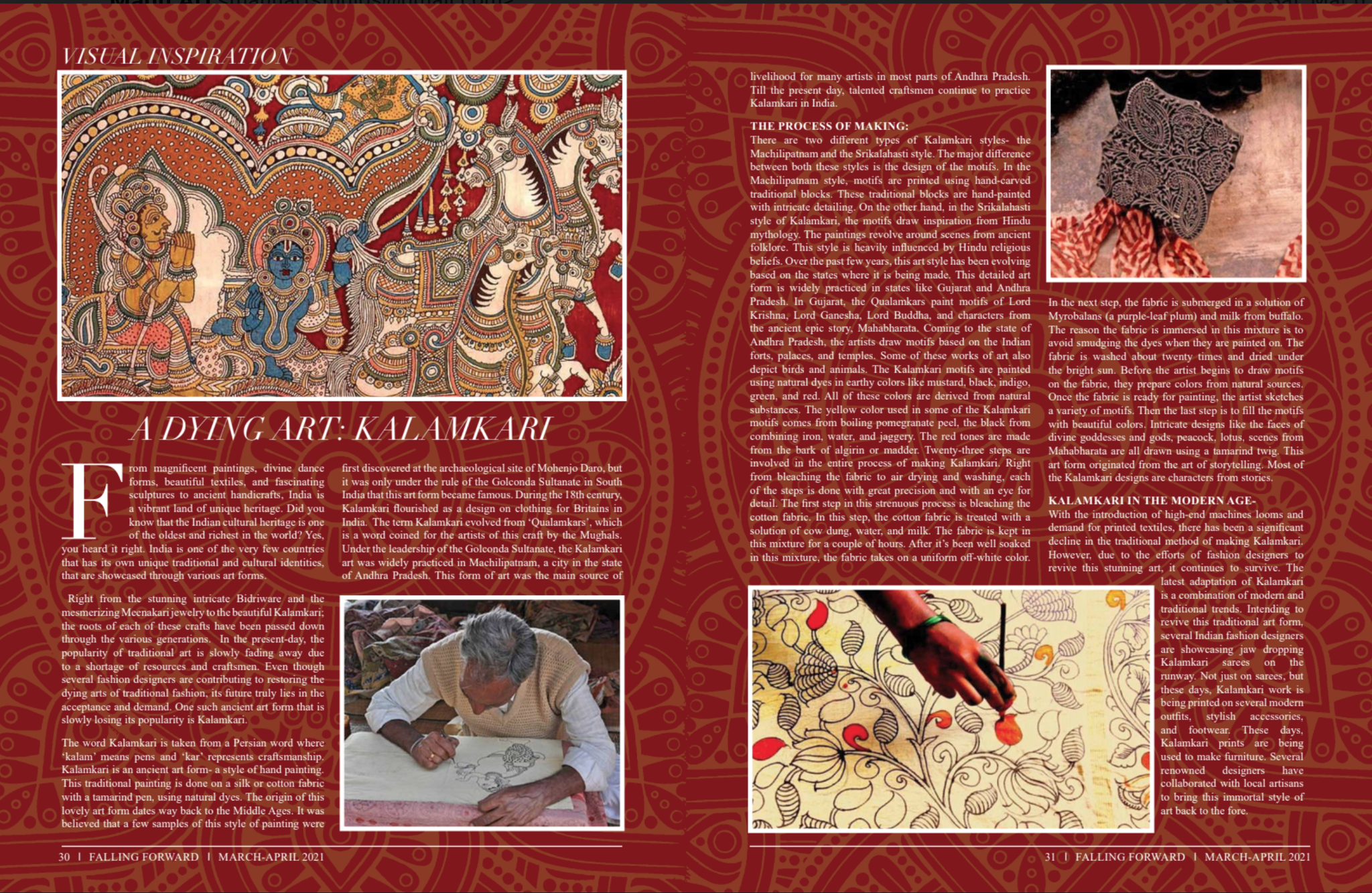A DYING ART : KALAMKARI
India is a vibrant land of unique heritage, from magnificent paintings, divine dance forms, beautiful textiles, and fascinating sculptures to ancient handicrafts. Did you know that the Indian cultural heritage is one of the oldest and most affluent globally? Yes, you heard it right. India is one of the very few countries with its own unique traditional and cultural identities showcased through various art forms.
From the stunning intricate Bidriware and the mesmerizing Meenakari jewelry to the beautiful Kalamkari, the roots of each of these crafts have been passed down through the various generations. Today, the popularity of traditional art is slowly fading away due to a shortage of resources and artisans. Even though several fashion designers contribute to restoring conventional fashion's dying arts, its future truly lies in acceptance and demand. One such ancient art form that is slowly losing its popularity is Kalamkari.
Kalamkari is taken from a Persian word where 'kalam' means pens and 'kar' represents craftsmanship. Kalamkari is an ancient art form- a style of hand painting. Using natural dyes, this traditional painting is done on a silk or cotton fabric with a tamarind pen. The origin of this lovely art form dates way back to the Middle Ages. It was believed that a few samples of this style of painting were first discovered at the archaeological site of Mohenjo Daro. Still, it was only under the rule of the Golconda Sultanate in South India that this art form became famous. During the 18th century, Kalamkari flourished as a design on clothing for Britains in India. The term Kalamkari evolved from 'Qualamkars,' a word coined for the artists of this craft by the Mughals. Under the leadership of the Golconda Sultanate, the Kalamkari art was widely practiced in Machilipatnam, a city in the state of Andhra Pradesh. This form of art was the primary source of livelihood for many artists in most parts of Andhra Pradesh. Right up to today, highly talented artisans continue to practice Kalamkari.
The process of making:
There are two different types of Kalamkari styles- the Machilipatnam and the Srikalahasti style. The significant difference between both these styles is the design of the motifs. In the Machilipatnam style, motifs are printed using hand-carved traditional blocks. These conventional blocks are hand-painted with intricate detailing. On the other hand, in the Srikalahasti style of Kalamkari, the motifs draw inspiration from Hindu mythology. The paintings revolve around scenes from ancient folklore. Hindu religious beliefs heavily influence this style. Over the past few years, this art style has been evolving based on the states where it is being made. This detailed art form is widely practiced in states like Gujarat and Andhra Pradesh. In Gujarat, the Qualamkars paint Lord Krishna, Lord Ganesha, Lord Buddha, and characters from the ancient epic story, Mahabharata. Coming to the state of Andhra Pradesh, the artists draw motifs based on the Indian forts, palaces, and temples. Some of these works of art also depict birds and animals.
The Kalamkari motifs are painted using natural dyes in earthy colors like mustard, black, indigo, green, and red. All of these colors are derived from natural substances. The yellow color used in some of the Kalamkari motifs comes from boiling pomegranate peel. The black comes from combining iron, water, and jaggery. The red tones are made from the bark of algirin or madder. Twenty-three steps are involved in the entire process of making Kalamkari. From bleaching the fabric to air drying and washing, each step is done with great precision and with an eye for detail. The first step in this strenuous process is bleaching the cotton fabric. In this step, the cotton fabric is treated with a solution of cow dung, water, and milk. The material is kept in this mixture for a couple of hours. After it's been well soaked in this mixture, the fabric takes on a uniform off-white color. In the next step, the material is submerged in a solution of Myrobalans (a purple-leaf plum) and milk from buffalo. The fabric is immersed in this mixture to avoid smudging the dyes when they are painted on. The material is washed about twenty times and dried under the bright sun. Before the artist begins to draw motifs on the fabric, they prepare colors from natural sources. Once the material is ready for painting, the artist sketches a variety of motifs. Then the last step is to fill the motifs with beautiful colors. Intricate designs like the faces of divine goddesses and gods, peacock, lotus, scenes from Mahabharata are all drawn using a tamarind twig. This art form originated from the art of storytelling. Most of the Kalamkari designs are characters from stories.
Kalamkari in the modern age-
With the introduction of high-end machine looms and the demand for printed textiles, there has been a significant decline in the traditional method of making Kalamkari. However, due to the efforts of fashion designers to revive this stunning art, it continues to survive. The latest adaptation of Kalamkari is a combination of modern and traditional trends. Several Indian fashion designers are showcasing jaw-dropping Kalamkari sarees on the runway to restore this standard art form. These days, Kalamkari work is being printed on several modern outfits, stylish accessories, and footwear, not just on sarees. These days, Kalamkari prints are being used to make furniture. Several renowned designers have collaborated with local artisans to bring this immortal art style back to the fore.
-Akhila

